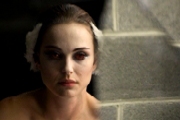|
|
|
|
il cigno nero |
|
|
|
|
|
|
|
|
26/30
|
|
|
Darren Aronofsky returns to the cinematography joined by his habitué Matthew Libatique, the cinematographer for all his movies. As the many movies Libatique directed in what concerns their cinematography, Black Swan isn’t an exception in providing the viewers with an intense sequence of captivating images that drives them to a complex plot about the encounter of the self with its other self manifested in the shape of an obscure persona who emerges in the mirror surface. What Matthew Libatique has already presented in Pi and Requiem for a Dream in matters of the ambiance of visual expression of an excessive obsession, happens again in Black Swan through the dark ambiances of some intimate narrow spaces lit in a very sharp dim light. These obscure and mysterious kind of scenes are opposed to the ones where big wide spaces lit in a bright diffuse light create a constant tension that concurs with the main character's affections. The colors that take part in the intermediation of Nina's self-transformation are also chosen as symbols of a kind of behavior and pre-disposition that the characters shows along the film. For instance, the fact that Nina (the main character) wears a lot of pink and is surrounded by pink, which is connoted to ballet, but also to sweetness, and that gradually she makes this color disappear from her way to dress, suggests the formation of another persona. An important scene to remark is one of the beginning scenes in which Nina performs the swan dances, where the camera is alternating from follow shots to medium close-ups, capturing the light movements of a dancer perfectly performing the smoothness of a swan's dance and, at the same time, confronting the viewer with a face and a body of constraint reflecting, the fear of rejection and a perfect dancing technique. In opposition to this constraint, a black swan dance demands the passion and detachment from a technique in order to enter a deeper level of affection, an unconscious to be delivered to, where the red color of her lips can be observed as its pressage. Black Swan contains an obvious organization through light, but also through color. The character of Nina, depicted as a fragile woman wearing light colors, faces her double in the mirror and in the face of Lilly (Mila Kunis), wearing black and seen as an indulgent figure. The choice for the camera to film from an upper view organized in a subjective shot from Nina's point of view the serpentine movements of Lily, a double sense perspective of her physical position and superior standing, although showing at the same time, some resentment for the imperfect but free movements that Lilly performs, perfectly suitable for the black swan dance. Black Swan celebrates the idea of a glorious body (from Giorgio Agamben), a body emptied of its functionality and given to a new common use, through many situations where the characters enter in dialogues of movement and sensuality. Also an ambiance of phantasmagoria is presented in the sharp cold colored images matching the rigid still faces of Nina and her mother Erica (Barbara Hershey), whose desire remains imprisoned in a guilty interiority, which, in Nina's case, will be abandoned so that an excess of life can enter as a disruption and bring some passion, noticeable in the warmth of its new colors. The collapse of an identity visible in the choice of multiple sequenced scenes of alternating faces of Nina and Lilly in the mirror, expressing the dissolution of a face so that an animal unconscious, a devenir animal, can take place in the body of Nina.
20:01:2011 |
|
|
black swan |
|
|
|
|

